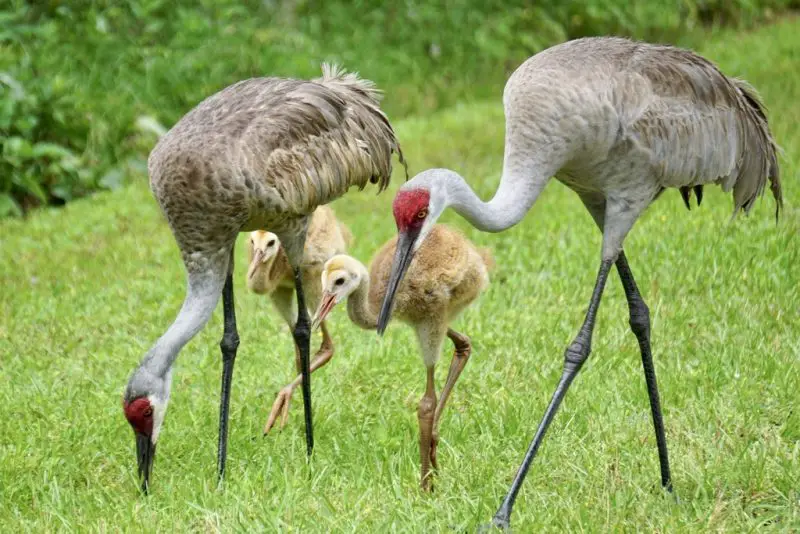Cranes are among the most iconic and graceful birds in Florida’s natural landscape. Known for their long legs, elegant necks, and powerful wings, these birds are more than just a beautiful sight — they are important members of the state’s wetland ecosystems. While Florida is home to many species of wading birds, there are only two true crane species that can be found here: the Florida Sandhill Crane and the Whooping Crane.
Both species share certain physical similarities, yet they are distinct in their size, coloration, behavior, and habitat preferences. Understanding the differences between these two cranes is essential for birdwatchers, wildlife photographers, and nature enthusiasts who wish to appreciate Florida’s biodiversity. This guide provides a detailed look at their appearance, identification features, behaviors, feeding habits, breeding patterns, and the conservation challenges they face.
Cranes in Florida: A Brief Overview
Cranes belong to the family Gruidae, a group of large, long-legged birds that inhabit wetlands, grasslands, and open fields around the world. These birds are known for their elaborate courtship displays, strong pair bonds, and loud, resonant calls that can travel great distances.
In Florida, cranes are not only part of the natural scenery but also a symbol of wild spaces that still remain in an increasingly developed landscape. Their presence signals the health of wetland habitats, and their disappearance often warns of environmental decline. Historically, Florida’s wetlands were abundant and provided year-round refuge for resident species as well as wintering grounds for migratory birds. Today, habitat loss, urban expansion, and changes in water management have challenged crane populations, making conservation efforts more important than ever.
Florida Sandhill Crane

Appearance and Identification
The Florida Sandhill Crane (Antigone canadensis pratensis) is a non-migratory subspecies of the Sandhill Crane. Standing between 3.5 and 4 feet tall with a wingspan of 6 to 7 feet, it is an imposing yet graceful bird. Its body is covered in soft gray feathers, often tinged with rust-colored staining caused by preening with muddy bills. The most recognizable feature is the bare patch of red skin on the forehead and crown, which becomes more vivid during the breeding season. Its long bill is straight and pointed, ideal for probing soil and shallow water in search of food.
While most individuals appear gray, the plumage can vary depending on age and season. Juveniles are more brownish and lack the bright red forehead seen in adults. In flight, the Florida Sandhill Crane stretches its neck forward and its long legs backward, producing a characteristic silhouette that differs from herons or ibises.
Habitat and Range in Florida
The Florida Sandhill Crane lives exclusively within the state and a small part of southern Georgia, making it a true Floridian resident. It thrives in freshwater marshes, open prairies, and pine flatwoods, as well as in pastures and agricultural fields. Unlike its migratory northern relatives, this subspecies does not leave the state, relying instead on the year-round availability of food and nesting areas.
Because of their adaptability, Florida Sandhill Cranes are sometimes spotted in suburban neighborhoods, golf courses, and roadside ditches, especially in regions where human development has encroached upon natural habitats. However, they still require access to shallow wetlands for successful breeding.
Feeding Behavior and Diet
Florida Sandhill Cranes are omnivorous, with a diet that changes according to seasonal availability. They feed on seeds, grains, tubers, small amphibians, reptiles, insects, and even small mammals. In wetlands, they probe the mud for aquatic plants and invertebrates. In agricultural areas, they often feed on leftover corn, peanuts, and other crops, making them familiar sights in rural farmlands.
Their feeding style is deliberate and methodical. They walk slowly with their heads lowered, occasionally jabbing their bills into the soil or water. Their long legs allow them to wade into shallow water where other ground-feeding birds might not reach.
Breeding and Family Life
Florida Sandhill Cranes are monogamous and mate for life, forming strong pair bonds that can last decades. Courtship involves an elaborate dance where the birds bow, leap into the air, and flap their wings dramatically. These displays are not only for attracting a mate but also for reinforcing the pair’s bond.
Nests are usually built in marshes or on small islands surrounded by shallow water. The structure consists of mounded vegetation, often raised above the water level to protect from flooding. The female typically lays two eggs, which both parents incubate for about a month. Chicks are precocial, meaning they can walk and feed themselves within hours of hatching, though they remain under the watchful care of both parents for several months.
Fun Fact
One of the most endearing traits of Florida Sandhill Cranes is their tolerance of human presence in certain areas. In some communities, it is common to see cranes strolling calmly across lawns or golf courses, seemingly unbothered by people. However, feeding them is prohibited, as it disrupts their natural foraging patterns and can lead to aggressive behavior.
Whooping Crane

Appearance and Identification
The Whooping Crane (Grus americana) is one of the most striking birds in North America and also one of the rarest. Standing about 5 feet tall with a wingspan of 7.5 feet, it is larger than the Florida Sandhill Crane and instantly recognizable due to its mostly white plumage. The only dark feathers are on the wing tips, which become visible during flight. Its face features a red crown and a black mask that extends from the bill to behind the eye.
When flying, the Whooping Crane extends both its neck and legs completely straight, a posture shared with Sandhill Cranes but in stark contrast to the tucked-neck flight of herons. Its loud, resonant “whoop” call — from which its name derives — can carry over a mile, especially across open wetlands.
Habitat and Range in Florida
Whooping Cranes once occurred widely across North America, but by the mid-20th century, hunting and habitat destruction had reduced their population to just 15 individuals. Today, they are the focus of intensive conservation and reintroduction programs. In Florida, small numbers of Whooping Cranes winter in designated conservation areas, including wildlife refuges and managed wetlands.
They prefer wide, open marshes and shallow wetlands where they can safely roost and forage. These areas offer both security from predators and access to abundant food sources.
Feeding Behavior and Diet
The diet of the Whooping Crane is varied and opportunistic. In wetlands, they consume crustaceans, insects, small fish, frogs, and aquatic plants. In agricultural landscapes, they may feed on waste grain, tubers, and small rodents. Like Sandhill Cranes, they forage slowly, scanning their surroundings while probing the soil or water with their bills.
Because they are highly alert and wary, Whooping Cranes are more difficult to approach or observe closely compared to Florida Sandhill Cranes. Their rarity also means that sightings are treasured among birdwatchers.
Breeding and Family Life
Most Whooping Cranes breed in Canada’s Wood Buffalo National Park, but non-migratory populations have been established in certain parts of the U.S. through reintroduction projects. Their nests are built in remote wetlands, typically on small islands or in shallow water, and are made from reeds, grasses, and other plant material.
Whooping Cranes usually lay two eggs, though often only one chick survives due to competition for food and parental attention. Both parents share incubation duties and protect the nest aggressively from intruders. The young remain with their parents for nearly a year, learning essential survival skills before becoming independent.
Fun Fact
The Whooping Crane’s recovery story is one of the most remarkable successes in bird conservation. From a mere 15 birds in the 1940s, the population has grown to several hundred individuals thanks to habitat protection, captive breeding, and careful management. However, the species remains endangered, and every individual is carefully monitored by conservation teams.
How to Tell Them Apart
Although both species are tall, long-legged, and elegant, their coloration provides the clearest distinction. The Florida Sandhill Crane is mostly gray with a red forehead, while the Whooping Crane is bright white with black wing tips, a red crown, and a black facial mask. Size is another difference, with the Whooping Crane being slightly taller and having a longer wingspan. Their calls are also distinctive — Sandhill Cranes produce a rolling, rattling trumpet, while Whooping Cranes emit a loud, pure “whoop.”
Location can be a useful clue as well. Florida Sandhill Cranes are widespread throughout the state year-round, while Whooping Cranes are confined to specific protected areas and are much rarer to see in the wild.
Conservation Challenges in Florida
Both crane species face threats from habitat loss, development, and human disturbance. Wetland drainage for agriculture and urban expansion reduces nesting and feeding areas, while road collisions pose a significant risk for cranes that feed near highways.
For the Florida Sandhill Crane, maintaining large tracts of undisturbed wetland is critical for sustaining its non-migratory population. For the Whooping Crane, the challenge is even greater, as each individual bird represents a significant portion of the global population. Conservation strategies include habitat restoration, predator control, and public education campaigns to reduce human interference.
The Joy of Observing Cranes in Florida
For birdwatchers and photographers, spotting a crane in the wild is an unforgettable experience. Early mornings in wetland preserves often provide the best opportunities, when cranes are actively feeding and their calls echo across the marshes. In some regions, especially central Florida, the Florida Sandhill Crane is so accustomed to humans that it can be observed at close range, allowing for excellent photographic opportunities.
Whooping Crane sightings, while rare, are even more rewarding due to the bird’s beauty and conservation significance. Witnessing one of these endangered giants in the wild serves as a reminder of the importance of preserving Florida’s natural heritage.
Final Thoughts
The Florida Sandhill Crane and the Whooping Crane represent two very different conservation stories. One is a year-round resident whose population remains stable but requires continued habitat protection; the other is a fragile survivor of near extinction, reliant on ongoing conservation programs. Together, they embody both the challenges and the possibilities of wildlife conservation in Florida.
By learning to identify and appreciate these cranes, we not only enrich our understanding of Florida’s birdlife but also contribute to efforts aimed at ensuring their survival for generations to come. Whether you are an avid birder or a casual nature enthusiast, encountering either of these cranes in the wild is a moment worth cherishing.
FAQs About Cranes in Florida
What types of cranes live in Florida year-round?
The Florida Sandhill Crane is a non-migratory subspecies that lives in the state year-round, nesting and feeding in wetlands and open fields.
Are Whooping Cranes common in Florida?
No. Whooping Cranes are rare and endangered, with only a small number wintering in Florida under strict conservation management.
How can you tell a Sandhill Crane from a Whooping Crane?
Sandhill Cranes are mostly gray with a red forehead, while Whooping Cranes are white with black wing tips, a red crown, and a black face mask.
Where is the best place to see cranes in Florida?
Florida Sandhill Cranes can be seen across central and northern Florida in wetlands and fields, while Whooping Cranes are found in protected areas.
What do cranes eat in Florida?
They eat a varied diet of seeds, grains, insects, small vertebrates, and aquatic plants, adjusting their food choices by season and habitat.






